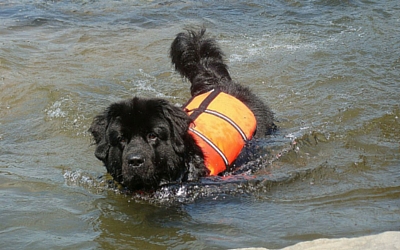
Summertime brings a plethora of fun, outdoor activities that your pets can enjoy with you. Here are 10 tips for keeping your animal companions safe and comfortable this summer, wherever your adventures may take you:
- Never leave your pet in a hot car. The most common cause of heatstroke for pets is being left in a car with inadequate ventilation on a warm day. In a hot car with poor air flow, an animal’s body temperature can rise rapidly and quickly become hazardous to their health. Animals should never be left unattended in a car during the summer months, even with the windows down. Parked cars can quickly reach deadly temperatures, even in the shade and with windows open. It only takes a few moments for a pet’s body temperatures to rise dramatically and put their safety at risk.
- Access to drinking water and shade. Other common causes of heat stroke and dehydration are being left outside on hot days without any shade or access to water. Always make sure your pet has some shade to escape to from the sun outside, and always, always supply lots of fresh, cool drinking water for them. Remember to bring bottles of water on walks and outings as well.
- Be aware of hot asphalt and other surfaces. Don’t walk your dog during the hottest part of the day—usually between 11am and 4pm. Instead, opt for cooler times like early morning and evening when the sun isn’t directly overhead. Be wary of how hot asphalt and other hard surfaces can get for a dog’s paws, and try to choose routes like gravel or woodchip paths, or even dirt roads for your daily walks to protect your pet’s paws. Try to keep pets inside during the hottest parts of the day as well.
- Don’t assume your pet can swim. Not all dogs like the water or are natural swimmers. If it’s your dog’s first summer near water, take it slow and don’t force or throw them into the water. Most cats will avoid water, although they are usually natural swimmers.
- Get a lifejacket. Even if your dog can swim, make sure you have a life jacket for him if you’re going boating, canoeing, or doing any other water activities that would require a human to have a lifejacket.
- Slather on the sunscreen. Skin cancer is the most common form of cancer in dogs, and dogs and cats both get sunburned! Animals that are white or light-colored, and hairless varieties, are especially at risk. Apply a specially formulated pet sunscreen to delicate, exposed areas like bellies and noses if they’re going to be spending some time outside or if your pet loves to sunbathe.
- Keep them restrained. In new outdoor environments, whether it’s a hike, camping trip, or cottage keep your dog on a leash until you trust them not to take after a chipmunk. It can be dangerous if they get too close to a road, or if they choose to tangle with the wrong wild animal.
- Make sure your pets are protected from ticks, fleas, and mosquitos. Campsites, hiking trails and other outdoor areas all carry a possibility of harboring ticks and fleas. Make sure you pet is up-to-date on their preventative medications, and if you are going to be in mosquito or fly-infested areas, look into getting an insect repellant made especially for pets to keep them bug-free. Any formulas containing DEET should never be used on animals.
- Fire safety. Summer brings fire-related activities like BBQs and campfires. Keep your dog on a leash and away open flames; do not let them try to retrieve sticks from a fire or grab food off a BBQ.
- Watch what treats your dog gets. Some things, like watermelon, make great summertime treats for your dog, but others like chocolate ice cream can be toxic for dogs. Be aware of what foods can be dangerous to your pet and make sure to avoid them.